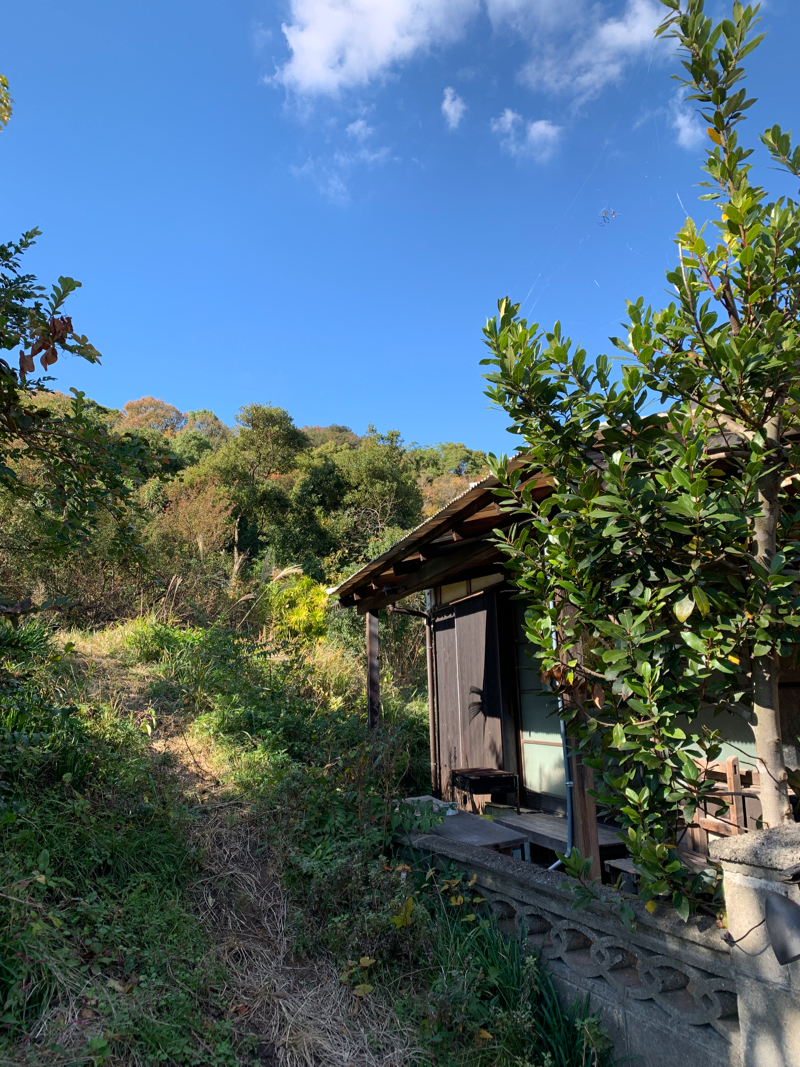Cafe Salon Naka-Oku: feminine home cooking on Naoshima
When visiting Naoshima, the abundant artscape on this small island in the Seto Inland Sea of Japan calls for a break. If you long for wholesome, feminine home cooking then Cafe Salon Naka-Oku is the perfect casual restaurant in Naoshima town to recharge your legs for more art miles.
The Cafe Naka-Oku is hard to find. Despite being a few minutes from the townhouse, your western phone map won’t show the tiny path cutting through the vegetable patches of the residential edge on Naoshima. Just follow the tiny sign and you will shortly arrive at the wooden cottage surrounded by green flora. People lining outside spark the light bulb in your brain. Arriving 15 minutes before the opening on a sunny day like ours, we did not mind the naturist wait. Once you miss the first seating however, you are set to linger and gaze into the forest behind the restaurant until the first round of diners finishes their meals. Beware, spiders are all over Japan, and Naoshima’s trees and bushes are wired through spider nets.



Set like a masters painting in nature, the wooden house of Cafe Salon Naka-Oku seduces visually with beautiful Japanese retro meets antique interior. Despite being quite small, there are a few distinct dining areas to eat. The designer was playful. Ceramic bowls planted with leafy greens hang on wires from the ceiling. Behind the bar, an exhibition-worthy display of China blue glazed cups with matching saucers pulls curiosity in. Even the rectangular window, ideal for singles on a digital detox, frames in a contemplative vista. The pomegranate tree bulging with plush red fruit in November, like the wild persimmon trees dotted around the island, provide more outdoor seasonal cues. Inside, raw, untreated meets polished wood, hanging lamps, dinging clock, hand-woven baskets, all combined somewhat slow down time. The long bar veiled away from the kitchen is also set perfectly for the solo diners more typical in Japan than elsewhere.


When invited in take off your shoes, wear the provided uwabaki over your socks and slip them into the box at the entrance (called genkan), and be ushered to your seat. Here, even your bag will be pampered in a straw box under your seat.
Cafe Salon Naka-Oku is a canvas for homely provisions including the warm service of the ladies who work here. On a windy autumn afternoon, walking inside embraces you with a cocooning welcome.
The beverage offering is humble yet intriguing. I went for a warm persimmon leaf brew, which I usually miss outside of Japan. Organic seasonal juices, local Shodoshima olives cider and a wide selection of coffee beverages, shoju and cocktails surely recharge you more. I was amused by the warning on the beverage menu: “Please note that alcohol is not available for those driving a car”. On a car-free island, where only special public buses operated by the Benesse foundation transport visitors and local workers, one must smile.


In our lunch set A (¥380, 580 with dessert) a drink or glass of Japanese draft beer was included.
To start we got a small Potato salad. Simple, whipped with yolk-bright corn kernels, this was a refreshing cold snack opened our appetites for the wholesome dishes to follow. You get quite large portions for Japan. As our steaming platefuls arrived, each of us gasped at the comforting fragrance of the food. This is what you want to eat on a breezy, cool day. My husband ordered Japanese curry rice with a rich curry sauce, a spice-balancing splash of coconut cream and neon-bright edamame beans. He was all over the moon. As a rice lover, the steamed yellow curry flavoured Japanese-grown rice was very much to his liking. His spoon got lost in my own portion rice once.
I liked his curry, but my meal was the real deal. You must love eggs, for the frisbee of an omelette covered my entire rice, my protein load was generously filling. Watch and you will crave some eggy pleasure, guaranteed! Spooning into the hot hill of moist eggy pleasure revealed the molehill of steamed rice underneath. Italian organic tomatoes were used for the juicy sauce refreshingly completing the rich dish.
Seasonal locally-caught seafood, seaweed and homemade cakes such as in Japan popular baked cheese and chiffon cakes are other temptations worth considering, but full enough we kindly emptied our seats for the waiting customers outside. The generous portions set Cafe Salon Naka-Oku apart from the miniature Tokyo office lifestyle portions and bring it closer in size to the foodie Osaka. The later about two hours journey on a combo of a ferry and car from Naoshima. The train nearby is not a shinkansen, so it is slower.
Queue up early enough for this is one of the best (the favourite of ours and the foodie couple we turn to for Japan tips) places to eat on the art island.
Open for Lunch 11:30-15h & Dinner 17:30-21h. Closed on Tuesdays and public holidays.









